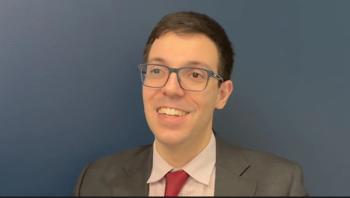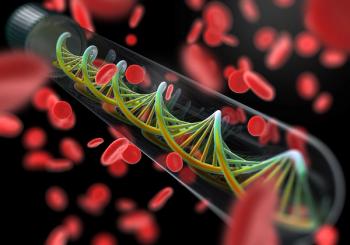
Oncology NEWS International
- Oncology NEWS International Vol 9 No 7
- Volume 9
- Issue 7
‘Unprecedented’ Survival Times Result From Adding Docetaxel to Treatment Regimen for NSCLC
DAVIS, Calif-“Unprecedented” survival times for patients with stage IIIB non–small-cell lung cancer (NSCLC) have resulted from adding taxane sequencing to combined-modality therapy with radiotherapy plus cisplatin (Platinol) and etoposide. These results from the Southwestern Oncology Group (SWOG) 9504 trial were presented at the ASCO meeting by David R. Gandara, MD, of the University of California Cancer Center, Davis.
DAVIS, CalifUnprecedented survival times for patients with stage IIIB nonsmall-cell lung cancer (NSCLC) have resulted from adding taxane sequencing to combined-modality therapy with radiotherapy plus cisplatin (Platinol) and etoposide. These results from the Southwestern Oncology Group (SWOG) 9504 trial were presented at the ASCO meeting by David R. Gandara, MD, of the University of California Cancer Center, Davis.
The approach involved initial treatment with the combined radiation/cisplatin/etoposide regimen, followed by two sequential administrations of docetaxel (Taxotere). At a press conference, Dr. Gandara called the results unprecedented and reported a 1-year survival rate of 78%, a 2-year survival rate of 48%, and a median survival of 22 months.
Following surgery or radiotherapy alone, the expected survival in this group of patients is generally less than 10%. The addition of chemotherapy has improved upon this figure, but the current SWOG study achieved the most favorable survival yet, he said.
The SWOG study documented tumor stage through biopsy of the primary tumor or the lymph nodes. Most clinical trials in stage III disease have not required this pathologic staging, Dr. Gandara pointed out.
The Regimen
The phase II trial included 83 patients, who were treated with cisplatin 50 mg/m2 on days 1, 8, 29, and 36; with etoposide 50 mg/m2 on days 1 to 5 and 29 to 33; and with concurrent radiation (1.8 to 2.0 Gy/day) starting on day 1 (61 Gy total). This was followed by consolidation docetaxel 75 to 100 mg/m² every 21 days for three cycles.
A previous SWOG trial followed the first part of this regimen, but without docetaxel as consolidation therapy. Instead, patients were treated with additional cycles of cisplatin/etoposide. That strategy achieved a 2-year survival rate of 34% and a median survival of 15 months.
In the subsequent trialSWOG 9504the investigators substituted taxane sequencing for the cisplatin/etoposide follow-up dosing, based on the potential molecular mechanisms of action of the taxanes, that is, that the activity of these agents is independent of p53. It is not clear whether the excellent outcome could be attributed to docetaxels action specifically or to a general taxane effect, he said.
The radiographic response in 83 patients included 3 complete responses (4%) and 49 partial responses (59%). Stable disease was noted in 23 (28%), and 8 patients progressed (9%).
Therapy Well Tolerated
The treatment was relatively well tolerated. Hematologic toxicity (assessed in 69 patients after consolidation docetaxel) included grade 3-4 neutropenia in 56% of patients; however, the duration was brief and only six patients developed neutropenic fever. There was one case of grade 3 thrombocytopenia and one infection-related death. Three deaths occurred from pulmonary complications; these were possibly late radiation reactions.
The regimen is fairly easy to administer and quite well accepted by patients, Dr. Gandara noted. We told the patients from day 1 that they would only have to receive three doses of docetaxelone shot every 3 weeksand at the end of the 9 weeks, they would be finished. I think they were more accepting of that sort of regimen, he remarked at the press conference.
Since this was a nonrandomized phase II trial, Dr. Gandara said that the investigators are cautious about being overly optimistic about the results. He added, however, that as the 3-year follow-up approaches, few patients have died, suggesting there may be an encouraging treatment plateau.
Articles in this issue
over 25 years ago
Couric Urges Doctors to Talk to Patients About Colon Cancerover 25 years ago
Automated Imaging Notification System Close to Fail-Safeover 25 years ago
Higher Dairy Consumption Linked to Prostate Cancer Riskover 25 years ago
First-Year Funding of Early Detection Research Network Completeover 25 years ago
Gritty Antitobacco Ads and More From Legacy Foundationover 25 years ago
Tositumomab Effective for Low-Grade Follicular Lymphomaover 25 years ago
New Awards Spotlight Courage of Cancer Survivorsover 25 years ago
Hospital Volume Shown to Predict Breast Cancer Outcomeover 25 years ago
New Drug Information Websiteover 25 years ago
NCCN Presents Updated Colorectal Cancer GuidelinesNewsletter
Stay up to date on recent advances in the multidisciplinary approach to cancer.















































































